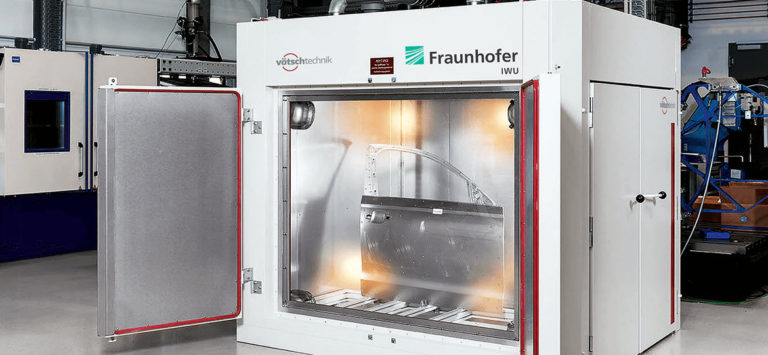Oven Simulates Curing of Adhesives in the Paint Drying Process

Dimensionally stable, lightweight components for energy-efficient cars
Hybrid structures in various materials are used for lightweight design concepts in vehicle construction. Differences in their thermal expansion coefficients can present a risk. To minimize this risk, we have developed an analysis oven which validates the models for simulating paint drying.
The bodywork plays one of the most important roles in the development of a new vehicle. Lightweight design concepts such as mixed constructions reduce the overall weight. The challenge here is to keep control of tolerances such as the accuracy of individual parts, the clamping, spot welding, folding and the drying of parts with cathodic dip coating (CDC drying). Variations in functional dimensions are visible and reduce the quality. In mixed constructions with aluminum, deviations from tolerance due to differences in thermal expansion can occur during thermal processes. This influences the quality of seals, closing forces and wind noise. A numerical prediction of the dimensional stability for early product assurance is therefore needed before the genuine parts and equipment become available in order to keep quality and costs within the planned range.
The Fraunhofer Institute for Machine Tools and Forming Technology (Fraunhofer IWU) in Dresden works on the prediction of assembly geometry as a function of the relevant process parameters. The focus here is currently on the development of methods for identifying parameters for the substitute models and representation of the dimensional changes resulting from the thermal expansion of components. Particular attention is required to the fixing of this state through the curing of adhesives in the paint drying process. To simulate the paint drying processes and validate the models experimentally, a Vötsch analysis oven was designed to permit precise control of the temperature of the components and their optical measurement during this process.
Two constraints were imposed on the oven as an experimental platform for the CDC drying process step. The temperature distribution must be uniform and the component deformation and movements must be recorded using optical measuring techniques. For this, the oven has a large window to permit precise optical measurement of the reference marks on the components, which can be covered for maximum energy efficiency. The temperature of 220°C corresponds to CDC drying conditions.
The temperature uniformity within the oven is ±2 K, i.e. in the best possible technical range. As soon as the oven is heated up, the heating power is reduced to one third during heating phase. Optimum temperature distribution is achieved by high air circulation and additionally supported by a special door construction. Air circulation is created by three blowers, enabling defined ramping up and down of the temperature with the help of an extractor fan and the program control. The known temperature profiles of CDC continuous ovens in bodywork construction can be optimally reproduced.
Aided by rails in the floor and a loading cart, the workpieces can be aligned, marked at the required reference points and positioned in the oven. To obtain precise measured values, the window is made of borosilicate glass with a low refractive index and a low coefficient of expansion. To provide good illumination under all circumstances, four temperature-resistant, individually switched and dimmable halogen spotlights are fitted in the working area of the oven.
A cascade control system permits precise control of the temperature on the workpiece, measured by up to six sensors attached to it. A special function of the S!MPAC® control system permits control via the hottest sensor.
Via an Ethernet interface, the oven can be connected to a supervisory computer system to make the captured data such as the temperature curve directly available in S!MPATI®.
The measurement method during temperature control consists of an in-line 3D geometric measurement (GOM PONTOS). Global component deformations and local expansion in the area of the joint due to differences in thermal expansion are analyzed. The substitute model for the oven process is verified by comparison of the deformations measured in the experiment with the predicted geometric deviations.
Thus, with this complex test system, the high-temperature behavior of the various materials used in mixed constructions can be analyzed. Precise measurement of the parts during the test procedure enables detection of possible expansions. Different materials can thus be tested and analyzed before the parts are mass-produced.

